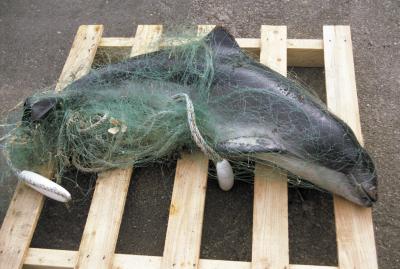Abstract

Gill nets yearly kill 300,000 cetaceans, including the harbour porpoise (Phocoena phocoena). Pingers transmit ultrasounds that keep harbour porpoises away from gill nets, which has resulted in a reduction of by-catch. But pingers also attract seals that damage fishing nets. The aim of this study was to investigate if harbour porpoises avoid pinger sounds that are inaudible to grey seals (Halichoerus grupus) and harbour seals (Phoca vitulina). An AquaMark 2246 prototype pinger transmitting traditional AquaMark 100 pinger sounds which were high-pass filtered to eliminate frequencies below 60kHz in 60-hour ON, 60 hour OFF schedule was deployed in the waters off Kullaberg, Sweden. Three Cetacean Porpoise Detectors (C-PODs) were deployed at 0, 100 and 400 meters from the pinger to record echolocation activity of harbour porpoises. Additional two C-PODs were deployed as controls, south and north of the test site. The number of Detection Positive Minutes per hour (DPM/h) were compared between pinger ON and OFF. The number of DPM/h was significantly decreased by 41.9 % at 0 meters, 28.3 % 100 meters and 30.2 % 400 meters from the pinger when the pinger was ON. The number of DPM/h was significantly decreased by 18.1 % at the South control and increased by 23.2 % at the North control when the pinger was ON. The results indicate that the “seal safe” pinger sounds had a deterrent effect on harbour porpoises and that they were displaced to the north side of Kullaberg when the pinger was ON.
Responsible for this page:
Director of undergraduate studies Biology
Last updated:
06/10/17
